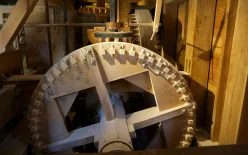
George Washington began his merchant milling business in 1770 with the construction of a new gristmill on Dogue Run Creek near Union Farm. In 1791, Washington upgraded his operation by installing milling improvements. This new automated method—known as the Evans system, after its inventor—moved grain and flour through all the steps in the milling process by mechanical means, with no need for manual labor.
The new system was invented by Oliver Evans, a Delaware native, who had been actively working on developing and refining his milling system since the early 1780s. The system also improved the quality and quantity of flour that could be produced in a mill. George Washington learned of Evans' improvements in 1790, when he reviewed and signed the patent application submitted to the newly-established United States Patent Office.
In addition to the patent review, Washington was aware of two mills already operating on the Evans system during the years of his first term as President. One was located near Mount Vernon in the village of Occoquan and the other was located along the Brandywine Valley near Wilmington, Delaware. The mill was owned by Joseph Tatnall, a wealthy miller, businessman, and devout Quaker. In 1777, Tatnall ground flour for Washington's troops as they suffered through the winter at Valley Forge.
Years later while on a presidential trip, Washington visited Tatnall to express his thanks for services rendered during the Revolution. Tatnall had recently equipped one of his two mills with the Evans components. The experience of viewing the mill in operation solidified Washington's decision to install the patented system at Mount Vernon. Washington's original gristmill was not an inferior performer. However, Washington realized that the Evans improvements would enhance his production of flour and increase his mill's profitability.

Washington purchased a license under the patent Evans had received, and by late summer of 1791 installation of the Evans system was well underway. Washington's millwright William Ball inspected the merchant mill at Occoquan to review the Evans machinery in detail, providing a template for his work at Washington's mill. In addition, two of Oliver Evans's brothers traveled to Mount Vernon to oversee the installation. At the time Washington's gristmill was one of only a handful of mills in the United States running the new automated system. For the remaining years of Washington's life his mill became more profitable than ever because of the Evans automated system.
The new automated system helped lessen the amount of labor needed to run the mill. In addition, a major gristmill was not an easy machine to operate, requiring a high level of skill and experience. The hopper boy was designed to spread and cool flour prior to final sifting. Before this Evans invention, the flour was raked by young workers called hopper boys. The Evans system replaced them with the automatic rake which greatly improved the production and quality of flour.
Recognizing that owners, builders, and operators of mills could use documented guidance, in 1795 Evans published The Young Mill-Wright & Millers Guide with the intent of promoting his milling improvements throughout the country. The book included sections on engineering principles and mill construction. In addition, twenty-five plates of detailed drawings of all components required in mills, helped provide a practical manual for those looking to install the automated milling system. Evans drafted the first four sections and Thomas Ellicott, a millwright from Bucks County, Pennsylvania, added the fifth section.
Evans' popular book was the first such detailed volume on mills and millwrighting to be published in the United States; George Washington ordered a copy even before it was published. A genius at marketing his creative system, Evans made sure that the first edition contained a list of subscribers which included a number of well-known farmers, merchants, and community leaders. At the top the list was "George Washington, President of the United States." The book continued its remarkable influence on American milling for years to come, with fifteen editions published between 1795 and 1860.
Bibliography: Bathe, Dorothy and Greville. Oliver Evans: A Chronicle of Early American Engineering. Historical Society of Pennsylvania, Philadelphia, 1935.
Canby, Henry Seidel. The Brandywine. New York: Farrar and Rinehart, 1941.
Evans, Oliver. The Young Mill-Wright & Millers Guide. Philadelphia: Carey, Lea and Blanchard, 1834.
Ferguson, Eugene S. Oliver Evans: Inventive Genius of the American Industrial Revolution. Hagley Museum and Library, 1980.
Pogue, Dennis J. and Esther C. White. George Washington’s Gristmill at Mount Vernon. Mount Vernon, Virginia: Mount Vernon Ladies Association, 2005.

Washington's Gristmill at Mount Vernon
Washington's Mount Vernon gristmill was not only an important part of his plantation economy, but also a technical marvel of its time.
